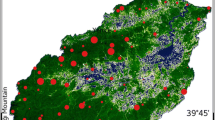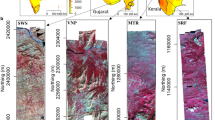Abstract
We estimated the number of species in a tropical forest landscape in Quintana Roo, Mexico, based on the relationship between reflectance values of satellite imagery and field measurements of plant species density (mean number of species per plot). Total species density as well as that of tree, shrub and vine species were identified from 141 sampling quadrats (16543 individuals sampled). Spatial prediction of plant diversity was performed using universal kriging. This approach considered the linear relationship between plant species density and reflectance values of Thematic Mapper™, as well as the spatial dependence of the observations. We explored the linear relationships between spectral properties of TM bands and the species density of trees, shrubs and vines, using regression analysis. We employed Akaike Information Criterion (AIC) to select a set of candidate models. Based on Akaike weights, we calculated model-averaged parameters. Linear regression between number of species and reflectance values of TM bands yielded regression residuals. We used variogram analysis to analyze the spatial structure of these residuals. Results show that accounting for spatial autocorrelation in the residual variation improved model R2 from 0.57 to 0.66 for number of all species, from 0.58 to 0.65 for number of tree species, from 0.26 to 0.41 for number of shrub species and from 0.13 to 0.17 for species density of vines. The empirical models we developed can be used to predict landscape-level species density in the Yucatan Peninsula, helping to guide and evaluate management and conservation strategies.





Similar content being viewed by others
References
Anderson DR, Burnham KP, Thompson WL (2000) Null hypothesis testing: problems, prevalence, and an alternative. J Wildlife Manage 64(4):912–923
Anderson DR, Burnham KP (2002) Avoiding pitfalls when using information-theoretic methods. J Wildlife Manage 66(3):912–918
Austin MP (2002) Spatial prediction of species distribution: an interface between ecological theory and statistical modeling. Ecol Model 157:101–118
Borrough PA, McDonnell RA (1998) Principles of geographical information systems. Spatial information systems and geostatistics. Oxford University Press
Burnham KP, Anderson DR (1998) Model selection and inference: a practical information-theoretic approach. Springer-Verlag, New York
Cabrera CE, Souza SM, Tellez VO (1982) Imagenes de la flora Quintanaroense. Centro de Investigaciones de Quintana Roo, Mexico
Campbell JB (1987) Introduction to remote sensing. The Guilford Press, New York
Carroll SS (1998) Modeling abiotic indicators when obtaining spatial predictions of species richness. Environ Ecol Stat 5:257–276
Clark DB, Palmer MW, Clark DA (1999) Edaphic factors and the landscape-scale distributions of tropical rain forest trees. Ecology 80(8):2662–2675
Earth Resource Mapping Ltd (1998) ER mapper 6.1. User guide, San Diego CA
Fairbanks HK, McGwire KC (2004) Patterns of floristic richness in vegetation communities of California: regional scale analysis with multi-temporal NDVI. Global Ecol Biogeogr 13:221–235
FAO (2001) Global Forest Resource Assessment 2000–Main Report. FAO Forestry Paper 140. FAO. Rome, Italy
French K (1999) Spatial variability in species composition in birds and insects. J Insect Conserv 3:183–189
Fuller RM, Groom GB, Mugisha S, Ipulet P, Pomeroy D, Katende A, Bailey R, Ogutu-Ohwayo R (1997) The integration of field survey and remote sensing for biodiversity assessment: a case study in the tropical forest and wetlands of Sango Bay, Uganda. Biol Conserv 86:379–391
Gaston KJ (2000) Global patterns in biodiversity. Nature 405:220–227
Guariguata MR (1990) Landslide disturbances and forest regeneration in upper Luquillo Mountains of Puerto Rico. J Ecol 78:814–832
Gould W (2000) Remote sensing of vegetation, plant species richness, and regional biodiversity hotspots. Ecol Appl 10:1861–1870
Hernández-Stefanoni JL, Ponce-Hernandez R (2004) Mapping the spatial distribution of plant diversity indices using multi-spectral satellite image classification and field measurements. Biodivers Conserv 13:2599–2621
Hernandez-Stefanoni JL (2005) Relationships between landscape patterns and species richness of trees, shrubs and vines in a tropical forest. Plant Ecol 179:53–55
Hernández-Stefanoni JL, Ponce-Hernandez R (2006) Mapping the spatial variability of plant diversity in a tropical forest: comparison of spatial interpolation methods. Environ Monit Assess 117:307–334
Hernández-Stefanoni JL, Bello-Pineda J, Valdes-Valadez G (2006) Comparing the use of indigenous knowledge with classification and ordination techniques for assessing the species composition and structure of vegetation in a tropical forest. Environ Manage 37(5):686–702
Isaaks EH, Srivastava RM (1989) An introduction to applied geostatistics. Oxford University press, New York
Isik K, Yaltikik F, Akesen A (1997) The interrelationship of forests, biological diversity and the maintenance of natural resources. Unasylva FAO 48:190–191
Johnson JB, Omland KS (2004) Model selection in ecology and evolution. Trends Ecol Evol 19(2):101–108
Jensen JR (2000) Remote sensing of environment: an earth resource perspective. Prentice Hall, New Jersey, 544 pp
Kerr JT, Southowood TRE, Chilar J (2001) Remotely sensing habitat diversity predicts butterfly species richness and community similarity in Canada. Proc Nat Acad Sci USA 98:11365–11370
Kitanidis PK (2000) Introduction to Geoestatistics. Applications in hydrogeology. Cambrige University Press
Moreno CE, Halffter G (2001) Spatial and temporal analysis of a, b, and g diversities of bats in a fragmented landscape. Biodivers Conserv 10:367–382
Muldavin EH, Neville P, Harpper G (2001) Indices of grassland biodiversity in the Chihuahuan desert ecoregion derived from remote sensing. Conserv Biol 15:844–855
Myers N, Mittermeier RA, Mittermeier CG, da Fonseca GAB, Kent J (2000) Biodiversity hotspots for conservation priorities. Nature 43(24):853–858
Nagendra H, Gadgil M (1999) Satellite imagery as a tool for monitoring species diversity: an assessment. J Appl Ecol 36:388–397
National Aeronautics and Space Administration (1998) Landsat 7 science data users handbook Greenbelt, Maryland, Goddard Space Flight Center, electronic version http://ltpwww.gsfc.nasa.gov/IAS/handbook/handbook_toc.html
Oindo BO, Skidmore AK (2002) Interannual variability of NDVI and species richness in Kenya. Int J Remote Sens 23:1195–1198
O’Neill RJ, Krummel JR, Gardner RH, Sugihara G, Jackson B, Deangelis DL, Milne BT, Turner MG, Zygmunt B, Christensen SW, Dale VH, Graham RL (1988) Indices of landscape pattern. Landscape Ecol 1:153–162
Palmer MW, Clark DB, Clark DA (2000) Is the number of tree species en small tropical forest plots nonramdom? Community Ecol 1(1):95–101
Pfeffer K, Pebesma EJ, Burrough PA (2003) Mapping alpine Vegetation using vegetation observations and topographic attributes. Landscape Ecol 18:759–776
Pitkanen S (1998) The use of diversity indices to assess the diversity of vegetation in managed boreal forest. Forest Ecol Manage 112:121–137
Plotkin JB, Potts MD, Yu DW, Bunyavejchewin S, Condit R, Foster R, Hubbell S, LaFrankie J, Manokaran N, Lee HS, Sukumar R, Nowak MA, Ashton PS (2000) Predicting species diversity in tropical forests. Proc Nat Acad Sci 97(20):10850–10854
Putz FE (1984) The natural history of lianas on Barro Colorado Island, Panama. Ecology 65:1713:1724
Robertson GP (2000) GS+: geostatistics for environmental science. Gamma Design Software. Plainwell, Michigan
Rocchini D, Chiarucci A, Loiselle SA (2004) Testing the spectral variation hypothesis by uing satellite multispectral images. Acta Oecologica 26:117–120
Schnitzer SA, Bongers F (2002) The ecology of lianas and their role in forests. Trends Ecol Evol 17:223–230
Silbaugh JM, Betters DR (1995) Quantitative biodiversity measures applied to forest management. Environ Rev 3:277–285
Tabachnick BG, Fidell LS (1996) Using multivariate statistics. Harper Collins College Publishers, New York
Thenkabail PS, Enclona EA, Ashton MS, Legg C, De Dieu MJ (2004) Hyperion, IKONOS, ALI and ETM+ sensors in the study of African rainforest. Remote Sens Environ 90:23–43
Tuomisto H, Ruokolainen K, Aguilar M, Sarmiento A (2003) Floristic patterns along 43 km long in an Amazonian rain forest. J Ecol 91:743–756
Pitkanen S (1998) The use of diversity indices to assess the diversity of vegetation in managed boreal forest. Forest Ecol Manage 112:121–137
Turner W, Spector S, Gadirner N, Fladeland M, Sterinling E, Steiniger M (2003) Remote sensing for biodiversity science and conservation. Trends Ecol Evol 18:306–314
Vieira IMG, De Almeida AS, Davidson EA, Stone TA, Carvalh CJR, Guerrero JB (2003) Classifying successional forest using Landsat spectral properties and ecological characteristics in eastern Amazonia. Remote Sens Environ 87:470–481
Voltz M, Webster R (1990) A comparison of kriging, cubic splines and classification for predicting soil properties from sample information. J Soil Sci 41:473–490
Waide RB, Willig MR, Steiner CF Mittelbach G, Gough L, Dodson SI, Juday GP, Parmenter R (1999) The relationship between productivity and species richness. Ann Rev Ecol Sistematics 30:257–300
Wagner HH, Wildi O, Ewald KC (2000) Additive partitioning of plant species diversity in an agricultural mosaic landscape. Landscape Ecol 15:219–227
Waring R, Coops NC, Ohmann JL, Sarr DA (2002) Interpreting woody plant richness from seasonal ratios of photosynthesis. Ecology 83(11):2964–2970
Webster R, Oliver MA (2001) Geostatistics for environmental science. John Wiley and Sons, LTD, Toronto, Canada
Whitmore TC (1997) Tropical forest disturbance, disappearance, and species loss. In: Laurance WF, Bierregaard ROJ (eds) Tropical forest remnants. The University of Chicago Press, Chicago, USA, pp 3–12
Wilcox BA (1995) Tropical forest resources and biodiversity the risk of forest loss and degradation. Unasylva FAO. 46(181)
Witting L, Loeschcke V (1995) The optimization of biodiversity conservation. Biol Conserv 71:205–207
Author information
Authors and Affiliations
Corresponding author
Rights and permissions
About this article
Cite this article
Hernández-Stefanoni, J.L., Dupuy, J.M. Mapping species density of trees, shrubs and vines in a tropical forest, using field measurements, satellite multiespectral imagery and spatial interpolation. Biodivers Conserv 16, 3817–3833 (2007). https://doi.org/10.1007/s10531-007-9182-6
Received:
Accepted:
Published:
Issue Date:
DOI: https://doi.org/10.1007/s10531-007-9182-6




